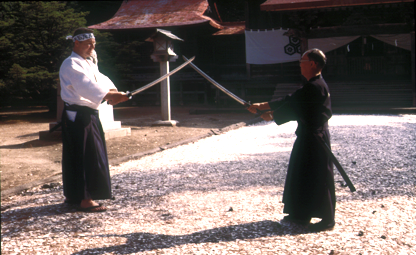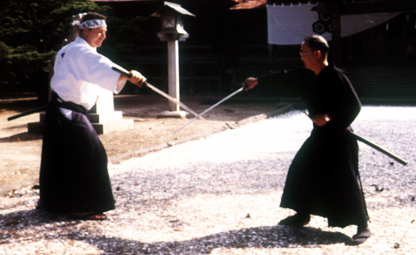
THE ART OF KENJUTSU
Why kenjutsu practice? Advantage which do I get?
» Tokimune Takeda wrote:
"Because of the fundamental principle that only
with the practice of the jujutsu it is not possible to learn
the true essence of the Daito-ryu, I called the art Daito-ryu
Aikibudo, especially because I, who have trained
with my father even in the body to body than in the sword,
perfectly realize to have to transmit the Ono-ha
Itto-ryu kenjutsu which was transmitted at Aizu
together the aikijujutsu, arts that are now only here with
us (at Abashiri)..."

THREE AREAS THAT MAKE UP THE KENJUTSU
The program of kenjutsu techniques studied in Daitokai is:
1. Kendo-kata
2. Gogyo-no-kata
3. Ono-ha Itto-ryu Takeda-den kata
KENDO KATA 剣道型
Kendogata #10 kata. These kata are a modern introduction (in
around 1912), developed to retain a direct relationship of
modern kendo with ancient schools of kenjutsu. To create the
Nihon kendonogata some kata were chosen among those over
charged from the famous ryu-ha at that time. The 5
representatives of the various ryu-ha representatives for
their creation were: Naito Takaraharu → Hokushin Itto-ryu,
Mona Tadashi → Hokushin Itto-ryu, Neigishi Shingoro → Shinto
Munen-ryu, Shinpei Tsuji → Jiki Shinkage-ryu, Takano Sasaburo
→ Ono-ha Itto-ryu.
Kata are fixed patterns that teach kendoka the basic elements
of swordsmanship. The kata include fundamental techniques of
attacking and counter-attacking, and have useful practical
application in general kendo. There are ten Nihon Kendo Kata.
Kata were originally used to preserve the techniques and
history of kenjutsu for future generations. Nihon Kendo Kata
were standardized in 1912 by combining the kata of many
kenjutsu schools into one set.
GOGYO NO KATA 五行の型
Gogyonogata #5 kata. Formalized by Takano Sasaburo in around
1904. Originally part of the Itto-ryu curriculum they include
some of the movements, concepts and strategies of the more
advanced kata of the Itto-ryu. [ The original kata are 5
odachi + 3 kodachi ] Are called the kata of ”five
principles“. Gogyo no kata are a set forms that were devised
by Takano Sasaburo and taught in the Tokyo Koto Shihan Gakko
(Tokyo Higher Normal School) in around 1904. These kata were
modified forms of kata taken from Ono-ha itto-ryu, of which
Takano Sasaburo was an exponent.
ONO-HA-ITTO-RYU 小野派一刀流 武田伝
Ono-ha Itto-ryu Takeda-den
Takeda Sokaku introduced in the school curriculum of the
Ono-ha Itto-ryu kenjutsu widespread at the Aizu clan (along
with the Mizoguchi-ha Itto-ryu) and he was of the greatest
exponent. Ono-ha Itto-ryu is the oldest of the many Itto-ryu
styles which branched off from Ittosai Kagehisa´s original
art. It continues to be one of the most influential of the
traditional kenjutsu styles today, exerting a major influence,
along with Hokushin branch, upon modern kendo´s kata, tactics,
and aesthetic. Ono-ha was founded by Ittosai's immediate
successor, Ono Jiroemon Tadaaki (1565–1628), from whence the
name of the art is derived. Oral tradition indicates that
Ittosai made Tadaaki fight a serious duel with another
student, Zenki, in order to establish a successor to the
style.
TRAINING INSTRUMENTS
1. Bokuto 木刀
The bokuto is the wooden reproduction of the Japanese katana
and preserves its shape, balance and weight. In the Ono-ha
style the bokuto has precise parameters that distinguish it
from the bokuto of other styles:
specific kissaki, a shallow sori and a greater weight.
2. Oni-kote 鬼甲手
Also called the "gloves of the demon" they are sturdy gloves
(kote) specific to the style. In fact all the kata end with a
real strong blow with the bokuto on the arm protected by the
glove.

 大東流合気武道大東会
大東流合気武道大東会

